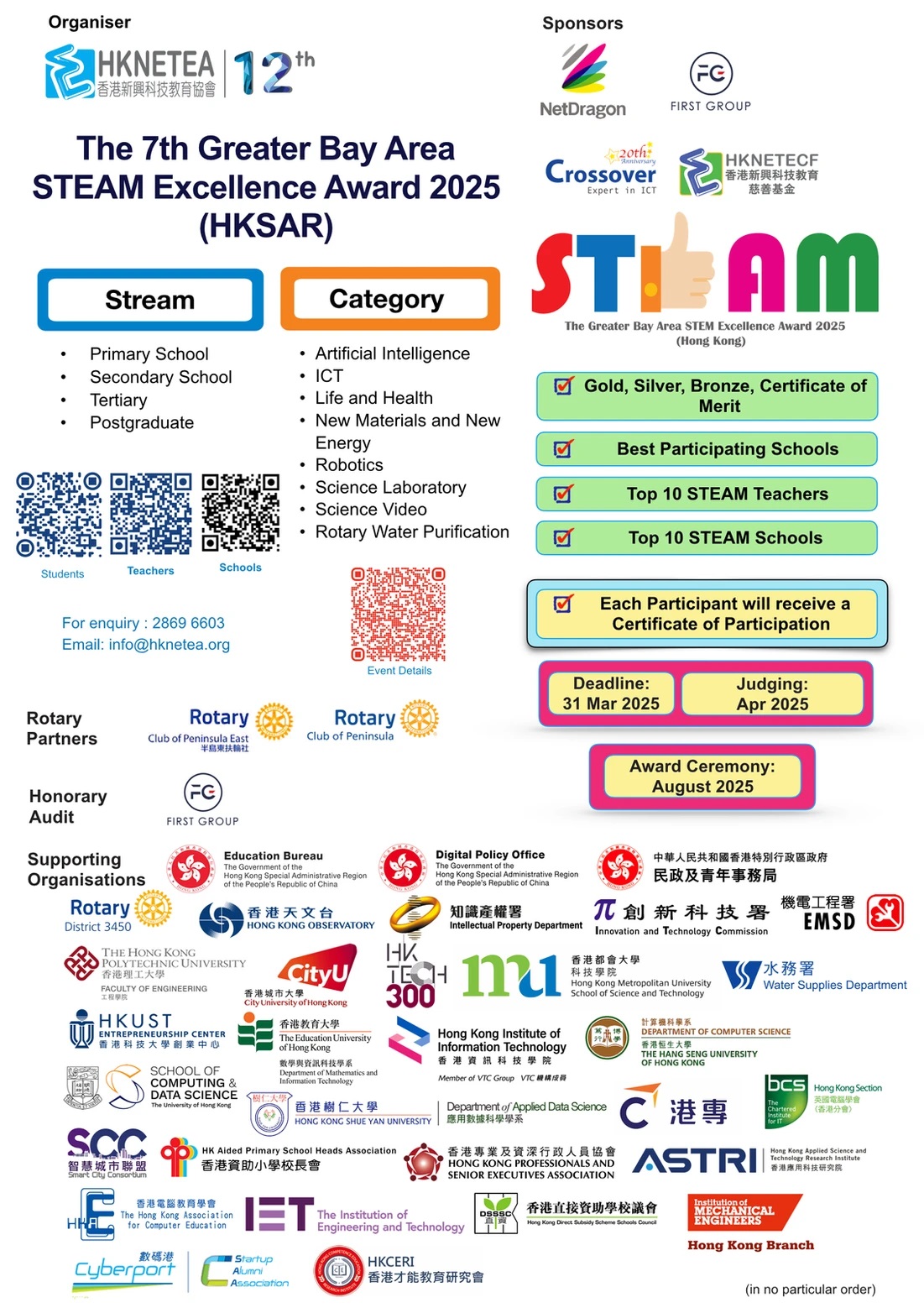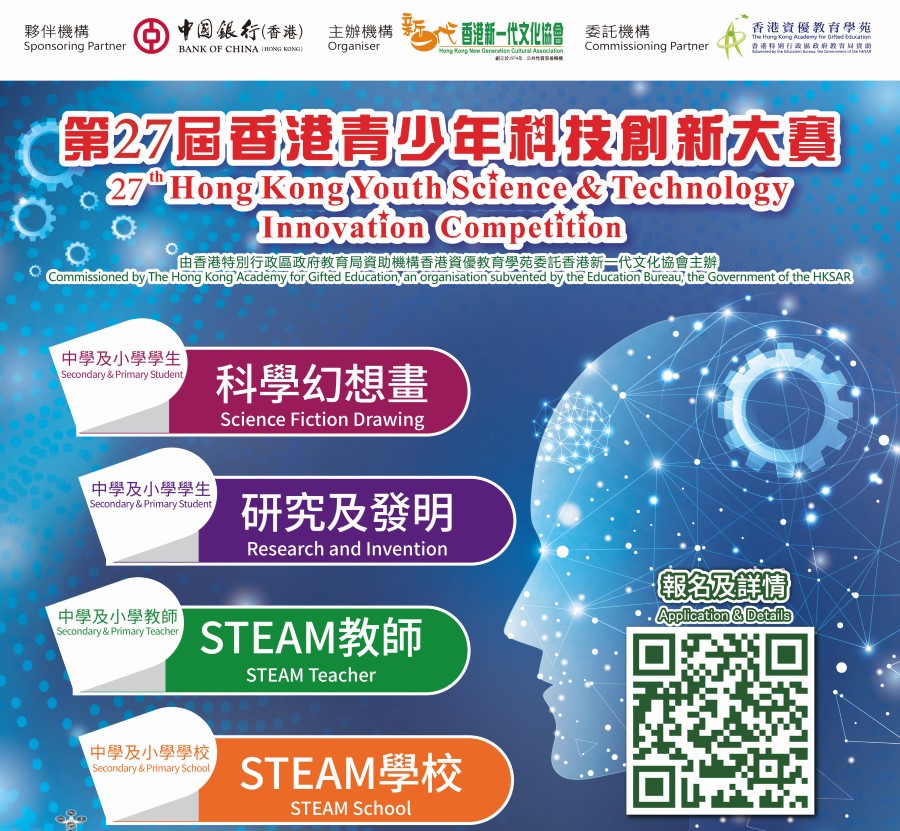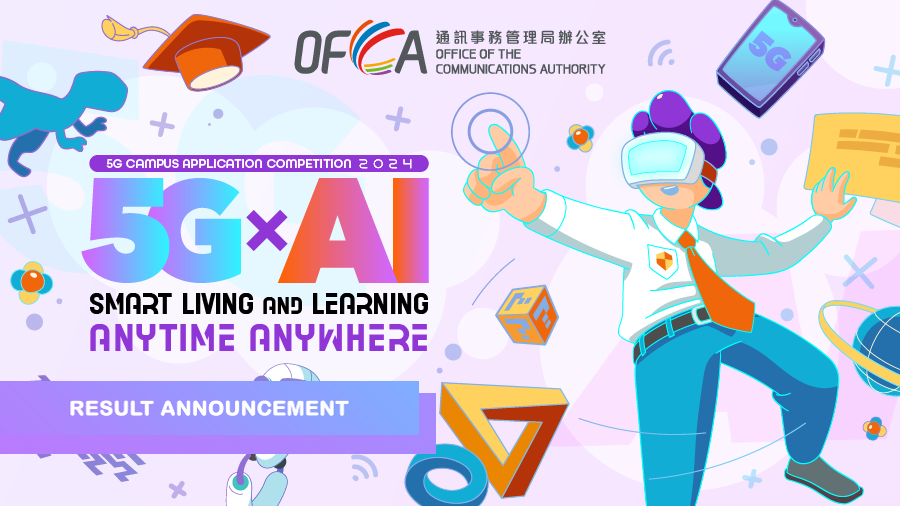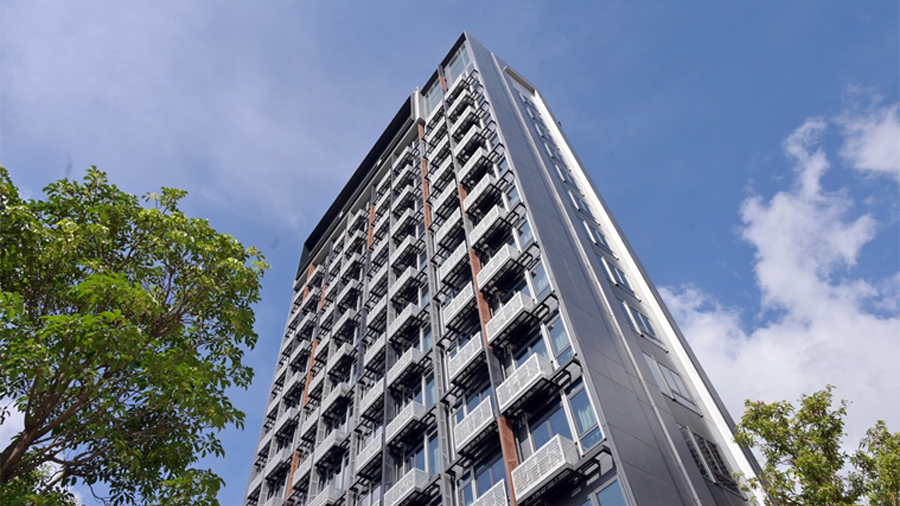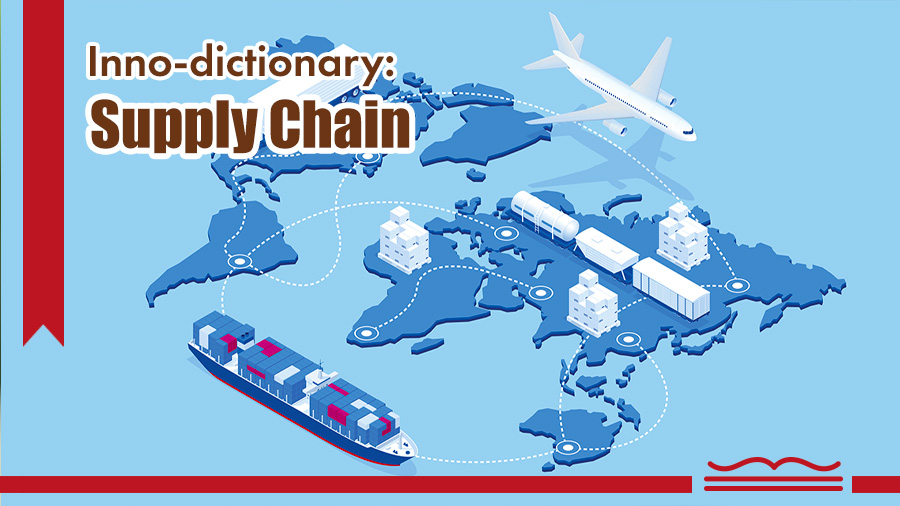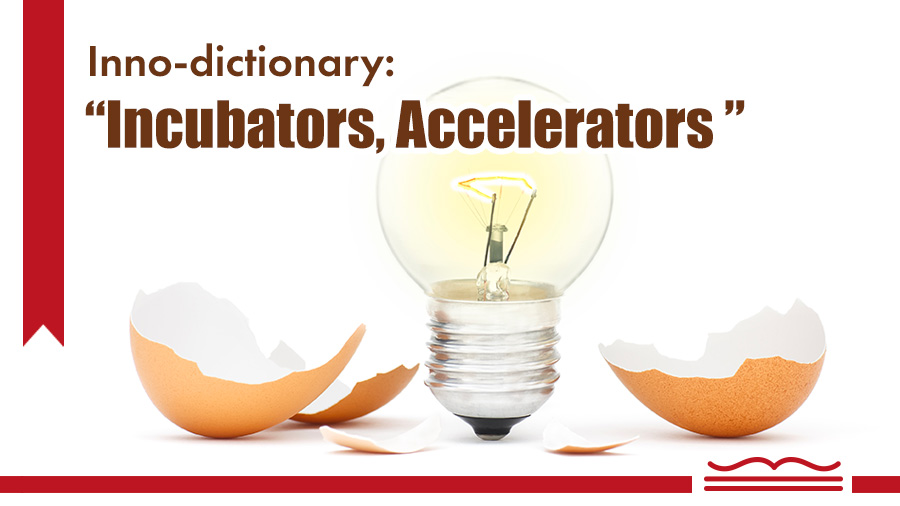#InnovationTech
Search Result: 9
Aims / ObjectivesThe Greater Bay Area STEAM Excellence Award (HKSAR) has been organized by Hong Kong New Emerging Technology Education Association (HKNETEA) since 2019 with the objective to enhance students’ creativity and innovation, and recognise young STEAM (Science, Technology, Engineering, Art and Mathematics) talents for their efforts, while recognizing the dedication of schools and teachers for their outstanding work and commitment to STEAM education.DetailsThe competition will be divided into streams : Kindergarten, Primary School, Secondary School, Tertiary and Postgraduate. Students can choose to participate in either individual or small groups of no more than five persons. In addition, there will be a Top 10 STEAM Teacher Award and Top 10 STEAM School Award.There are eight categories of The 7th Greater Bay Area STEAM Excellence Award 2025 (HKSAR):Artificial Intelligence,Information and Communication Technologies (ICT)Life and Health,New Materials and New Energy,Robotics,Science Laboratory,Science Video andRotary Water PurificationApart from our past categories, the following new categories are introduced :Life and Health: expect innovative projects addressing health challenges. These may include research on disease prevention, advancements in medical technology, studies on mental health, and solutions for improving overall well-being.New Materials and New Energy: projects that explore innovative materials with enhanced properties or sustainability. This includes research on renewable energy sources, energy-efficient technologies, and environmentally friendly materials.Science Video: engaging, informative videos that effectively communicate scientific concepts. Projects should demonstrate creativity and clarity in explaining experiments, research findings. Emphasis on visual storytelling, audience engagement, and educational value is crucial for impactful submissions.
Since 1997, the Hong Kong New Generation Cultural Association has been organising the "Hong Kong Youth Science and Innovation Competition." This "Science & Innovation Competition" has become the largest and most representative STEAM competition in Hong Kong. It is hailed as the "Cradle of Young Scientists" and the "Birthplace of Star Boys/Girls," discovering a large number of outstanding science and innovation talents, including more than a dozen "Star Boys/Girls" and multiple "Tomorrow's Little Scientists." Through participating in the "Science & Innovation Competition," they have stood out and been recommended by the association to participate in the largest national and global science competitions, achieving remarkable results and becoming notable science and innovation stars in Hong Kong academia.Target AudienceAll primary and secondary school students, teachers, and schools across Hong Kong.For teams or students representing Hong Kong in national or international competitions organized or co-organised by the Hong Kong New Generation Cultural Association, their awards (such as first, second, third or other representative awards) and relevant student information (such as name, grade and school name, etc.) will be archived in the "Education Bureau Hong Kong Outstanding Student Database" of the Education Bureau's Gallery for the public to browse after verification.
The Employees Retraining Board (ERB) launches the "Love ITㆍUpgrading Scheme" with over 50 innovation and technology-related training courses spanning across domains of "New Digital Skills" and "Technology Applications in Industries", with a view to encouraging lifelong learning of new digital skills among the public and supporting the digital transformation of industries.
The Office of the Government Chief Information Officer implemented the "IT Innovation Lab in Secondary Schools" Programme in the school year 2020/21, followed by the "Knowing More About IT" Programme in the school year 2021/22. The two programmes provide funding for publicly-funded secondary and primary schools to organise IT-related extra-curricular activities, with a view to fostering young students’ interest in I&T and spirit of scientific exploration at different learning stages and from an early age, enabling them to build a solid foundation for I&T knowledge. Sharing of the Participating Schools Appeal to Schools for Application Details and Application For more information, please refer to the programme website (https://www.it-lab.gov.hk/en/index.php). Should you have any queries, please contact the One-stop Support Centre.
InnoCell is a smart living and co-creation space designed for I&T talents to spark collaboration within Hong Kong Science Park. All of the spaces are designed with a well-considered balance between aesthetics and functionality. InnoCell’s vision is to develop an I&T co-creation community where its values and structures align with its residents’ needs. At InnoCell, a new way of living has been created with a focus on a genuine sense of community, where the use of shared spaces and smart living technologies helps to build greater personal interaction and collaboration — resulting in a network of likeminded talents who inspire one another and have a positive impact. Eligibility Criteria The 17-storey InnoCell provides over 500 beds. Apart from the Science Park's company founders, Mainland or overseas employees, it is also open to visiting academics, scientists and technology talents. InnoCell’s monthly rent is set up to around 60% of the market price of a similar property in the neighbourhood. The maximum lease period is one year. Experience Innovative Smart Living with Four Types of Unit There are four types of units: THE SOLO, THE TWIN, THE SUITE and THE POWERHUB. THE POWERHUB, with eight individual studios plus a private working area, is an ideal space for a project team to assemble and brainstorm. THE POWERHUB THE SOLO It is not all work and no play at InnoCell. There is an approximately 30,000 sq ft common area that includes meeting rooms, a library area, and a gym, etc., offering tailored communal facilities for the residents. For admission and more information about InnoCell, please visit the website of HKSTP and InnoCell.
“Incubators" & "Accelerators” Definition: Supply chain refers to various units involved in the production and sales procedures, including raw material suppliers, producers, distributors, retailers and end consumers. More information: With funding from the Innovation and Technology Fund, the Government of the Hong Kong Special Administrative Region founded the Logistics and Supply Chain MultiTech R&D Centre (LSCM) in 2006. Since its inception, LSCM’s mission has been to foster the development of core competencies in logistics and supply chain related technologies in Hong Kong, and to facilitate the adoption of these technologies by industries in Hong Kong as well as Mainland China. Please visit https://www.lscm.hk/ for further information. Source: Talent.gov.hk, LSCM The “Inno-dictionary” series aims to facilitate startup newbies to understand the jargons related to entrepreneurship as well as innovation and technology.
“Incubators" & "Accelerators” Definition: Incubators are organisations which help startups to overcome business challenges and achieve stable development by providing various assistance including mentoring and co-working spaces. Accelerators refer to programmes that aim at assisting startups to achieve rapid business growth. They would usually provide assistance such as funding support and workshops to help startups to connect with large enterprises and attract investments. More information: According to InvestHK’s 2021 Startup Survey, the total number of locations of co-working spaces, incubators and accelerators has doubled from 62 in 2017 to 124 in 2021 despite the challenges brought by the epidemic. For more information on incubation and acceleration programmes, please visit Startmeup.hk. Source: Talent.gov.hk, Startmeup.hk The “Inno-dictionary” series aims to facilitate startup newbies to understand the jargons related to entrepreneurship as well as innovation and technology.
In 2021, two tropical cyclones, Lionrock and Kompasu, hit Hong Kong one after another. As we know, with heavy rainfall always comes a bigger risk of landslides. In 1972, the catastrophic landslide at Po Shan Road in the Mid-Levels shattered a number of buildings, including the 12-storey Kotewall Court, and took away 67 lives. Afterwards, the Geotechnical Engineering Office (GEO) under the Civil Engineering and Development Department (CEDD) implemented a series of landslip prevention and mitigation works in the Po Shan area, among which was the Po Shan Drainage Tunnel. Completed in 2009, the Po Shan Drainage Tunnel reduces the risk of major landslides by controlling the groundwater levels with innovative technology and becomes one of the most iconic landslip prevention and mitigation projects in Hong Kong. Besides, to convey the importance of slope safety to the public, the Landslide Sci-Tech Chamber has been set up by the GEO in the tunnel. Innovative groundwater regulation systemGiven that the Po Shan area was prone to high groundwater levels, making it susceptible to landslides, the GEO designed and built the Po Shan Drainage Tunnel in 2009, it uses an innovative and sustainable groundwater regulation system to control the groundwater levels, replacing the ageing horizontal drains installed in the 1980s. Geotechnical Engineering Graduate of the GEO, Miss Ip Ching-tung, Gloria, tells us that the Po Shan Drainage Tunnel comprises a pair of drainage tunnels (3.5m in diameter and 500m in total length) and 172 sub-vertical drains (with the longest being 100m) installed with the technique of “up-the-hole hammering” inside the narrow tunnels. It is also equipped with an automatic real-time groundwater monitoring system. When the groundwater reaches a relatively high level in times of intense rainfall, the system will alert colleagues with text messages and automatically regulate the switches to keep the groundwater levels within a specified range, thereby improving the stability of the hillside against large-scale landslides to safeguard public safety.Retractable Tunnel Boring MachineMiss Gloria Ip says that, apart from adopting the “up-the-hole hammering” technique for the first time in Hong Kong, project staff introduced a Retractable Tunnel Boring Machine (TBM) for boring the two drainage tunnels. After boring one of the tunnels, the TBM retracted to its original position to bore the other tunnel. A receiving shaft at the tunnel end to retrieve the boring machine was no longer needed. The adoption of this innovative technique shortened the time required to bore the tunnels to four months and also greatly reduced the environmental impact of the project.Landslide Sci-Tech ChamberThe GEO has set up the Landslide Sci-Tech Chamber in the uniquely designed Po Shan Drainage Tunnel, with guided tours to educate the public on the importance of slope safety. The chamber is divided into galleries of different themes, e.g. the Po Shan Memorial Gallery, which exhibits historical photos and records of the Po Shan Road landslide incident, reminding the public of the tragedy and the lesson learned; the Climate Change Impression Gallery, which illustrates how global warming has led to more extreme rainstorms, and explains the importance of sustained effort to ensure slope safety under extreme weather. Incorporating STEM education elementsAssistant Geotechnical Engineer of the GEO, Mr Fung Yat-fan, Dominic, adds that STEM education and interactive elements are incorporated into the chamber to make the guided activities more fun. For example, the Landslide Wisdom Gallery makes use of video clips to help participants revisit the history of landslides in Hong Kong of more than a century as well as the development of the Hong Kong Slope Safety System; the Drainage Tunnel Expression Gallery utilises Augmented Reality (AR) to visualise the operation of sub-vertical drains and introduce the innovative technology of the groundwater regulation system.Booking a guided tourTwo students who have earlier taken part in the guided tour describe their feelings about the visit to the Landslide Sci-Tech Chamber, remarking that it has been quite a new experience, such as seeing first-hand how the system works to monitor the groundwater levels in real time and to lower the levels automatically and manually. They also got a close look at the “robotic dog” and learned how the GEO mitigates the risks of landslides using innovative technology. The Landslide Sci-Tech Chamber is now open to the public, schools and organisations for guided tours; reservations can be made through the GEO’s Hong Kong Slope Safety website. For those of you who are interested, don’t miss this out! Stay alert to landslide risksClimate change gives rise to extreme weather, making landslide prevention and mitigation even more challenging. As Head of GEO, Dr Cheung Wai-man, Raymond, says, they hope that the guided tours can educate the younger generation on the history of landslides in Hong Kong, keeping them alert to the risks, and that the public can better understand how colleagues in the GEO eagerly utilise technology to manage the risks of landslides. Certainly, the public should stay away from slopes during a rainstorm or when a landslip warning is in force; and it is the responsibility of owners to carry out timely maintenance of private slopes and retaining walls as prevention. (The video is in Cantonese) (The video is provided by Development Bureau)






